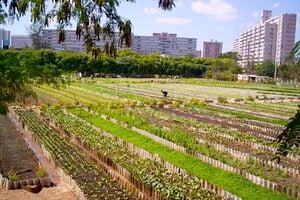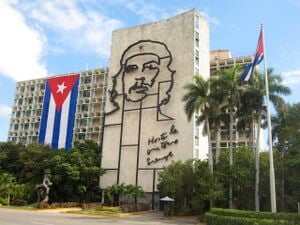
According to a 2012 study, Cuba is the only country in the world to meet the conditions of sustainable development put forth by the WWF. W
Cuba, officially the Republic of Cuba, is an island country, comprising the island of Cuba, Isla de la Juventud, archipelagos, 4,195 islands and cays surrounding the main island. Cuba is located where the northern Caribbean Sea, Gulf of Mexico, and Atlantic Ocean meet. Cuba is located east of the Yucatán Peninsula (Mexico), south of both the American state of Florida and the Bahamas, west of Hispaniola (Haiti/Dominican Republic), and north of Jamaica and the Cayman Islands. Havana is the largest city and capital; other major cities include Santiago de Cuba and Camagüey. The official area of the Republic of Cuba is 109,884 km2 (42,426 sq mi) (without the territorial waters) but a total of 350,730 km2 (135,420 sq mi) including the exclusive economic zone. Cuba is the second-most populous country in the Caribbean after Haiti, with over 11 million inhabitants.
The territory that is now Cuba was inhabited as early as the 4th millennium BC, with the Guanahatabey and Taíno peoples inhabiting the area at the time of Spanish colonization in the 15th century. It was then a colony of Spain, and slavery was abolished in 1886, remaining a colony until the Spanish–American War of 1898, when Cuba was occupied by the United States and gained independence in 1902. In 1940, Cuba implemented a new constitution, but mounting political unrest culminated in the 1952 Cuban coup d'état and the subsequent dictatorship of Fulgencio Batista. The Batista government was overthrown in January 1959 by the 26th of July Movement during the Cuban Revolution. That revolution established communist rule under the leadership of Fidel Castro. The country was a point of contention during the Cold War between the Soviet Union and the United States, and nuclear war nearly broke out during the Cuban Missile Crisis of 1962. Following the dissolution of the Soviet Union, Cuba faced severe economic downturn in the 1990s, known as the Special Period. In 2008, Fidel Castro retired after 49 years; Raúl Castro was elected his successor. Raúl Castro retired as president in 2018 and Miguel Díaz-Canel was elected president by the National Assembly following parliamentary elections. Raúl Castro retired as First Secretary of the Communist Party in 2021 and Díaz-Canel was elected.
Food activism[edit | edit source]

Cuba's agrarian revolution originated in the mountains of the Sierra Maestra when Law No. 3 of the Rebel Army was formally proclaimed in October of 1958. The principle of the law: Land should be given to those who tilled it; with the goal of massive land distribution.
The first Agrarian Reform Law was enacted on May 17, 1959. The second Agrarian Reform Law was enacted in October of 1963. These laws made the agricultural systems of Cuba socialist. Agricultural production cooperatives began in 1975, and were enacted August 24, 1982, as a superior form of collective production of social property started after the farmers' decision to join their lands and other means of production.[1]
The first agrarian reform created cooperatives and then consolidating agricultural production in state farms. The second created the agricultural production cooperatives (CPAs) and the third was the 1993 law creating UBPCs. These abbreviations come from the Spanish names.[2]
Video[edit | edit source]
- Cuba's DIY Inventions from 30 Years of Isolation on youtube
News and comment[edit | edit source]

2016
Why So Many Havana Residents Grow Their Own Food, Jan 29[3]
2015
The farmer who's starting an organic revolution in Cuba, August 31[4]
2011
Guardians of Cuba's urban green spaces, by Elaine Diaz,[5] November 1
2009
Sustainable Medicine, Cuba and Peak oil,[6] Oct 20

